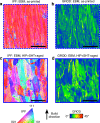A defect-resistant Co-Ni superalloy for 3D printing
- PMID: 33009416
- PMCID: PMC7532182
- DOI: 10.1038/s41467-020-18775-0
A defect-resistant Co-Ni superalloy for 3D printing
Abstract
Additive manufacturing promises a major transformation of the production of high economic value metallic materials, enabling innovative, geometrically complex designs with minimal material waste. The overarching challenge is to design alloys that are compatible with the unique additive processing conditions while maintaining material properties sufficient for the challenging environments encountered in energy, space, and nuclear applications. Here we describe a class of high strength, defect-resistant 3D printable superalloys containing approximately equal parts of Co and Ni along with Al, Cr, Ta and W that possess strengths in excess of 1.1 GPa in as-printed and post-processed forms and tensile ductilities of greater than 13% at room temperature. These alloys are amenable to crack-free 3D printing via electron beam melting (EBM) with preheat as well as selective laser melting (SLM) with limited preheat. Alloy design principles are described along with the structure and properties of EBM and SLM CoNi-base materials.
Conflict of interest statement
UCSB has a pending patent (T.M.P. and S.P.M. as inventors) on SB–CoNi alloys: "High Temperature Oxidation Resistant Co-based Gamma/Gamma Prime Alloys DMREF-Co", US patent application number US16/375,687, publication number US20200140978A1, international patent application number PCT/US2019/025882, international publication number WO2019195612A1. All other authors declare no competing interests.
Figures







References
-
- Yap CY, et al. Review of selective laser melting: materials and applications. Appl. Phys. Rev. 2015;2:041101. doi: 10.1063/1.4935926. - DOI
Grants and funding
LinkOut - more resources
Full Text Sources

